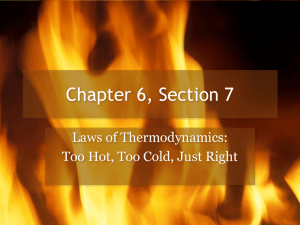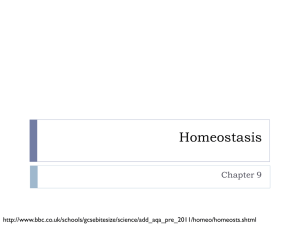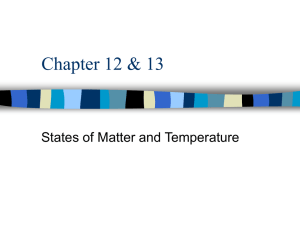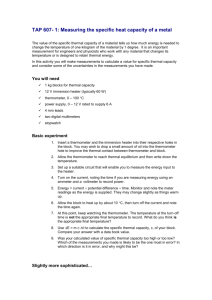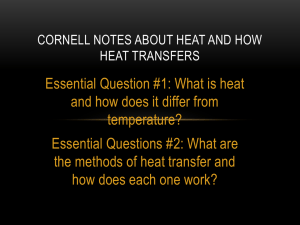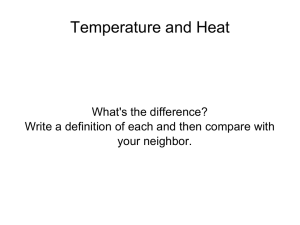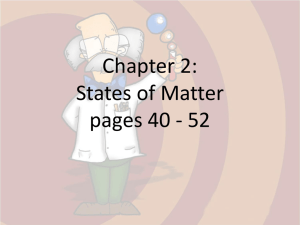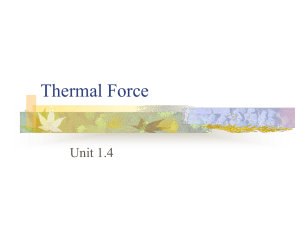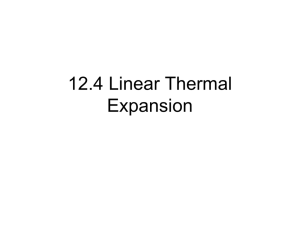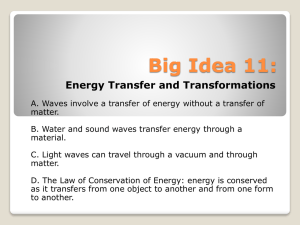Chapter 16 notes
advertisement
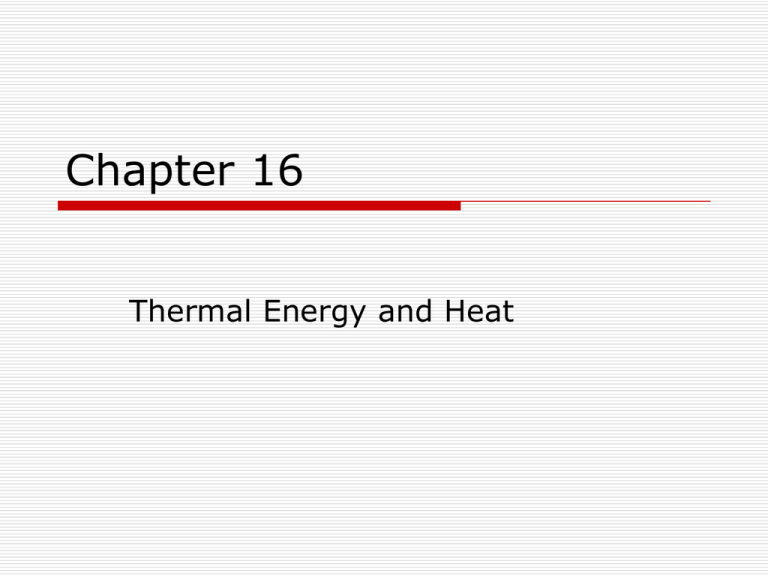
Chapter 16 Thermal Energy and Heat Thermal Energy and Matter Heat: is the transfer of thermal energy from one object to another due to a difference in temperature Heat flows from: HOT COLD Cold: losing heat energy Hot: gaining heat energy Kinetic Theory- all matter is made of particle (atoms, molecule, ions). These particles are always in random motion. Higher Temp = higher kinetic = faster motion Temperature: is how hot or cold an object is compared to some reference point Examples: Outside Temperatures Temperature of buildings 70.0’F Runoff Water Temp. 35-42’F Body Temp. 98.6’ F Thermometer: tool used to measure temp. 3 different scales ‘C ‘F K Mercury expands as the thermometer gains heat (UP) Mercury contracts as the thermometer loses heat (DOWN) Formulas pg 255 C F, F C Thermal energy: depends on mass, temperature and phase of an object. Thermal energy is caused by the movement of atoms and molecules (friction) Mass: greater mass = greater thermal e. More mass = longer to heat up & cool down Temp. greater temp = greater thermal e. Greater SpecificHeat = Greater thermal E Phase: depends on amount of thermal E. Solid: Liquid: Gas: Plasma: most heat energy The States of Matter, Molecular Stickiness, and Thermodynamicsitl.chem.ufl.edu Thermal Expansion: occurs because particles of matter tend to move faster and spread out as temperature increases INCREASE HEAT = INCREASE SIZE DECREASE HEAT = DECREASE SIZE Ex. Joints in side walks (celotex), joints in bridges, thermostats in homes, Thermometer Balloon Demo: expanded as we added heat Specific Heat: a physical property that describes how a substance absorbs heat Different substances absorb heat at different rates The lower a material’s specific heat, the more its temp. will increase as heat is added. (heats & cools faster) Metals: low specific heat Nonmetals: high specific heat Specific Heat of Common Materials Water = Plastic = Air = Iron = Silver = 4.18 J/g-’C 1.8 to 2.1 J/g-’C 1.01 J/g-’C .449 J/g-’C .225 J/g-’C Measuring Heat Changes Calorimeter: is an instrument used to measure changes in a material’s heat Closed container that holds water, thermometer, stirring rod Used to calculate specific heat Used to calculate # of calories in food Picture on next slide and in book http://www.agro.cmu.ac.th/department/fe/equip http://www.agro.cmu.ac.th/departme nt/fe/equip_file/031_1.jpg http://www.agro.cmu. ac.th/department/fe/e quip_file/031_1.jpg http://research.chem.psu.edu/mallouk/ilab/models.htm l 16.2 Heat & Thermodynamics There are 3 ways that thermal energy is transferred from one object to another Conduction Convection Radiation Conduction: is a heat transfer when 2 objects are touching (direct contact) There is NO transfer of matter Conduction works fastest with: Solids Liquids Gases The particles of liquids and gases are farther apart than solids, therefore heat is not transferred as quickly Thermal Conductors: are materials that allow heat and electricity to pass through them easily Metals Copper wire for electrical circuits, gold wire in spaceships, pots & pans Low specific heat values Thermal insulators: are materials that DO NOT allow heat and electricity to pass through them easily Non-metals Wood, plastic, air, glass, fiberglass Protect items from heat and electricity High specific heat values Convection: heat transfer that takes place in fluids (liquids and gases) HOT AIR/WATER RISES Convection Currents: currents in liquids or gases, these currents transfer thermal energy (caused by difference in density) Ex. Pavement, beaker of hot water, ocean currents, weather patterns, wind Radiation: is the transfer of thermal energy (heat) by waves through space Radiation happens through air and empty space Ex. Sun, wood burning stove, fireplace, candles All objects radiate thermal energy 1st Law of Thermodynamics: states that thermal energy is conserved Heat energy can’t be created nor destroyed Heat energy can only be transferred and converted 2nd Law of Thermodynamics: states that heat CAN flow from COLDER objects to HOTTER objects, ONLY if work is done. Ex. refrigerator, freezer, A.C. Freon: refrigerant liquid/gas that is used in the cooling process (cars) ENTROPY: The measure of how dispersed the energy is. 3rd Law of Thermodynamics: states that absolute zero CAN’T be reached Absolute Zero: is the coldest possible temperature where molecular (atoms) motion stops Absolute Zero = 0 K Using Thermal Energy Heating Systems: Forced-air: fuel heats air and fan pushes through the building. Cold air returns Radiator:hot water or steam heat through radiation to the air. Uses a boiler to heat water Electric: electricity heats coils in floor or ceiling by conduction.


